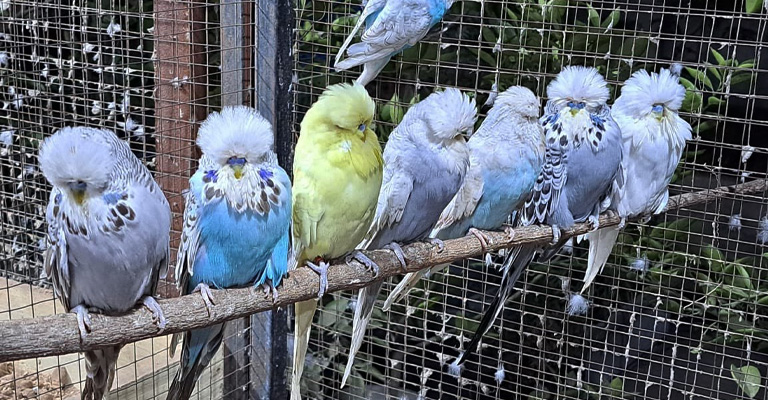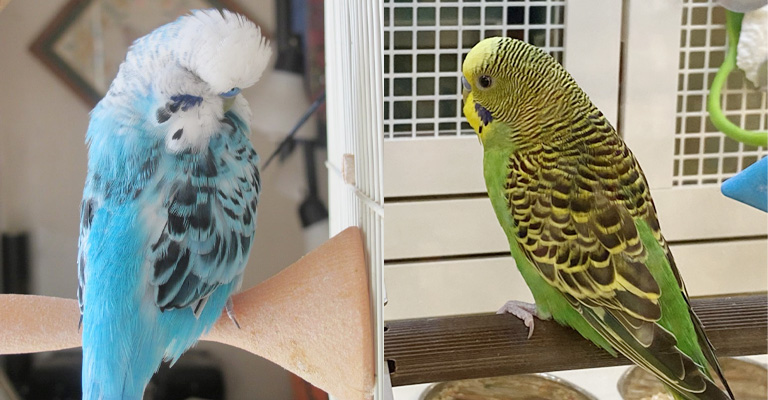Research shows that 45% of Americans have English budgies as pets. That’s over 200 million people in a single country. Imagine the number worldwide.
Why do people love English budgies so much? There has to be a reason, right? They are colorful, adorable, and most importantly easy to handle. And, you can set them anywhere!
For people who love pets like me, the English Budgies can be an ideal solution with low maintenance. Compared to other birds and four-legged friends, it is almost effortless to manage them.
This is why we will talk about English Budgies – Origins, Differences, & More today. Let’s get started.

About the English Budgies,
The English budgies are not the regular common budgerigar. Most people often can’t find the difference between them! But don’t worry. If you are one of them, we will help you get to the point.
The English budgies are a unique variation of the common Budgerigar (Melopsittacus undulatus). They are also known as the exhibition budgie. It’s worth the name. Let us tell you why.
Identification Features: English budgies are easy to identify but hard to differentiate from the common budgerigars. They are usually larger than their wild counterparts, measuring between 7 to 8.5 inches (18 to 22 cm) in length.
Additionally, they have a stockier and more robust build compared to the slimmer body of wild Budgerigars.
Their diversity of colors is another thing! They present a range of color mutations and patterns. You can have pairs of them and each of them will look different in colors, including blues, greens, yellows, and even rarer mutations like lutinos and albinos.
They are also fluffier and more rounder than the wild budgerigars. Also, most people love them for their friendly and sociable behavior.
The English budgies tend to be more amenable to human interaction and can readily bond with their owners. They are often more comfortable with handling and may readily step onto a finger or hand without much hesitation.
Next? Let’s learn a bit about where they come from.
The English Budgies – Origin
Let’s start with the original budgerigars first. The original ones are native to Australia. They generally live in the arid regions.
The English Budgie, however, is not a distinct species but rather a selectively bred variation of the wild budgerigar. In fact, nobody really noticed them before 1840. They began to pop up around that time.
Some theory says the origin of English budgies is traced back to the early 19th century. It was around that time when the native and wild Australian budgerigars were imported to England from their native habitat.
Later, it went through generations of careful breeding to develop specific traits and ultimately resulted in the foundation of the English Budgies. Eventually, we get to see the larger, more laid-back, and more colorful budgies of today.
You may think what if I come by one of the wild budgerigars and the shopkeeper sells me one instead of the English bugies? In the next section of our article, you will learn how to differentiate the two. Let’s get started.
English Budgies Vs. Budgerigars

The English Budgies and the Budgerigars are more likely the same. However, the English ones go through selective breeding. And there are some differences you may not notice if not too careful. Our guide is for you.
| Subject | English Budgies | Native Budgerigars |
| Size | English Budgies are notably larger than wild-type Budgerigars, usually ranging from 7 to 8.5 inches (18 to 22 cm) in length. | On the other hand, the wild Budgerigars typically measure around 6.7 inches (17 cm). |
| Body Features | English Budgies have a more robust and stocky build. They have a wider chest and shorter tail feathers. | Wild Budgerigars, on the contrary, have a sleeker and slimmer body. |
| Plumage (Collective Feathers) | The plumage is often more abundant and appears fluffier. They come in a wide range of colors and patterns. | Generally have green plumage with yellow faces and blue cheek patches. |
| Head & Face | Their heads are rounder and broader than that of a wild Budgerigar. They usually have a larger and more pronounced cere (the fleshy area above the beak). | Native budgerigars have a shallow head and generally come with a less pronounced cere. |
| Male & Female | The cere’s color helps distinguish gender: blue for males and brown or tan for females. | In this case, the cere is also the part to differentiate between male and female. For males, the cere is blue or pink. For females, the cere is bluish-white or brown. |
| Nature | English Budgies tend to be more sociable and comfortable with human interaction. They can be easily tamed. | Wild budgerigars are more skittish and reserved in nature. |
| Tails | They have shorter tail feathers. | Compared to the English budgies, they have longer tail feathers. |
| With Other Birds, | They are usually more comfortable in the presence of other birds. | Not too often. They live in packs with the birds of their community. |
How Do I Get An English Budgie and Not A Wild One?
Have you gone by our article? Then you should already know by now what are the unique features of an English budgie.
Additionally, we recommend you purchase your English Budgies from a reputable breeder who specializes in English Budgies. They will not provide you with any less than what you are bargaining for and also, ensure you are getting a true English Budgie.
Plus, from your side, you should also research properly before finally going to a store. Also, ask about the bird’s pedigree and lineage to verify its background.
What More to Know?
With our article, you now genuinely know more about the English Budgies how they vary from native Budgerigars, additionally where they come from.
We also have another section to guide you with, how do you take care of an English budgie? We will leave that in the comment section. Tell us how many English Budgies you have and how they are doing, also tell us how are you maintaining their diet.
For better suggestions, we are here for you. Also, share our article with your friends who need to know more about the two budgerigars before onboarding one. It will also help us grow too.